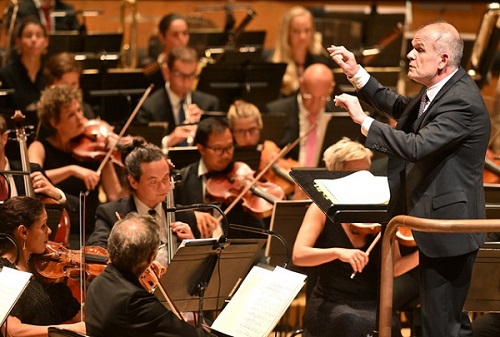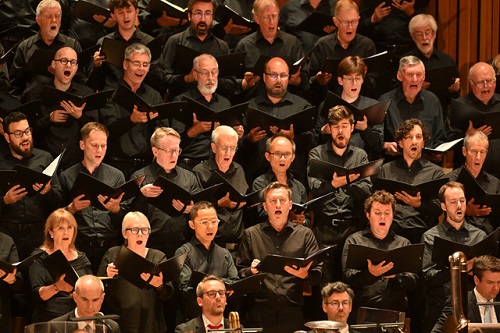When I look for a classic French orchestral sound I’d normally turn to an orchestra such as the Paris Conservatoire Orchestra or the Orchestre de la Société des Concerts du Conservatoire; I’d not especially turn to today’s Orchestre de Paris to find it. Paul Paray, but especially André Cluytens, were my introduction to this unique Francophone sound world. It is, however, a bit of a misnomer to just think of the French sound emerging only from the era of Debussy and Ravel. More important, especially at the turn of the twentieth century, were the influences from le fin siècle – Wagner, Rimsky-Korsakov, Mussorgsky and the music of Spain, Russia and the orient.
The eroticism of Wagner’s music – found in Tristan und Isolde – and the massive sonorities from his final opera, Parsifal, had a partial effect. The timbre of these orchestras, however, came from their bass – the chord tone and the non chord-tone – luminous harmonies and expressive woodwind solos. While British and American orchestras had changed to valved brass, French orchestras didn’t. On recordings alone, a slightly later Sinfonie fantastique from 1964 with Clutytens and the OSdCC, for example, sounds very dissimilar to one made six years earlier with the English Philharmonia Orchestra. Today, I’ve often struggled to find anything unique about the major French ensembles.
It’s against this background that François-Xavier Roth founded Les Siècle, a French orchestra which could perform music as close as possible to the original sound one might have experienced at the turn of the century. I dislike applying the term “period orchestra” to them simply because they are very much more than this. This concert of Debussy, Weber/Berlioz, Lili Boulanger and Ravel was both enlightening and often gripping. And, despite the incongruity of the meaning behind the lines themselves, Edgard Allan Poe, came to mind: “All that we see and seem, is but a dream within a dream”. A great deal of this concert I spent with my eyes closed allowing the music to go to places it rarely does in a concert hall.

Debussy’s Prélude à L’après-midi d’un faune is one of his most evocative and sensuous works; but it is also one that is prone to being played with cloying over-indulgence by orchestras. Les Siècles don’t have a notable warmth in their tone – there is a sang froid to some of their playing in fact – but this makes their colours so very sharp. Their playing often had the freshness of new blade-sharpened pencils; lines in this Debussy were ravishing in their detail, as complex as the most decorative drawing. Each note was cut into the bar with precision. Debussy’s Prélude à L’après-midi d’un faune is a work where silence is as important as the music itself, and here the caesuras were meaningful, the breath between each pause a part of the texture. The faun of the title is represented by the solo flute and here the soloist of Les Siècle – Marion Ralincourt – was sublime. The dreaminess of her playing, the subtlety of the phrasing and exquisite control – everything about it had the poetry of Mallarmé running through it. Although you felt almost compelled to crook your neck like a crane to look at her, it felt just as natural to close one’s eyes and let the sound just create the illusion for you. It’s precisely what great playing should do – and what it did here.
If French orchestras are perhaps less notable for their ensemble playing and more for their expressivity as chamber musicians, or soloists, then perhaps François-Xavier Roth designed the program to frame his orchestra in this light. The Debussy had partly shown this; the Weber also did. Weber’s Invitation to the Dance, orchestrated by Hector Berlioz, is something of an orchestral rarity in that it throws the solo onto the cello – and from the very opening bar. (The cello also ends the work – something which clearly threw some of audience who thought the work had come to a close after the tutti.)
Berlioz orchestrated this piano work for Weber’s Der Freischütz when it was performed at Paris Opéra in 1841. Les Siècles gave a buoyant, spirited performance of the piece – but it was once again the solo that so vividly sticks in the mind. Sébastien van Kuijk, had the most burnished of tones, one that, as TS Eliot wrote, ‘turns shadow into transient beauty’; it was often breathtaking, vivid – and much too short, really.
Lili Boulanger, who died from intestinal tuberculosis at the age of twenty-four, has always reminded me in some ways of Allan Pettersson. They have little in common when it comes to musical style; but they share that one factor of their music having the early twentieth century’s detachment from a wider humanity, where the composer’s alienation and despair is more a reflection of their own embodiment of illness and personal psychological struggles. Pettersson’s symphonies have crippling periods of longevity to them with little let up in their intensity – a reflection of his chronic arthritis and immobility. For Boulanger, the works are often short, but the effect is nevertheless of music with an indeterminate outcome; her music, too, often conceals beneath those moments of considerable surface beauty explosive outbursts – when they arrive it feels like electro-shock treatment.
D’un soir triste (1918) was originally composed as a trio – for violin, cello and keyboard. Boulanger orchestrated the work herself and its sound is distinctly symbolist. François-Xavier Roth’s layout of Les Siècles with antiphonal violins, and the harp almost part of the violin section itself, could have been made for
D’un soir triste. With the work sometimes needing first violins – as well as cellos – to play divided the performance emerged with crystalline clarity. The celeste, which rarely plays without the accompaniment of the harp, was almost spectral. The bass drum rumbled like a distant thunderstorm; but its sudden explosion was like erupting shellfire. Only the tam-tam felt a little odd, a tad hollow, although perhaps this was more because the instrument was an earlier piece than ones we are used to hearing in the twenty-first century.

The only work after the interval was Ravel’s complete ballet, Daphnis et Chloé. It is becoming less rare to hear the score in full these days (this is the second one I have heard in a year) but great performances of it remain scarce, not least because yoking a great chorus and orchestra together can be difficult. The ballet is almost everything that defines early twentieth century French orchestral colour: the influence of Scheherazade, exotic textures, dream-like sonorities. If Roth brought out slightly more brawniness in the string playing (one was sometimes drawn irresistibly to the double basses on the left) the transparency in the playing remained as clear-sighted as ever.
Le Siècles spun their sound as if they were weaving a web of thin silk; the string playing alone was extraordinarily refined, the subtle vibrato so slight as to be imperceptible. If the music had a pulse, the instruments followed it with their own beat. The horns were intoxicating, their colour much less ambiguously bright toned than we are used to hearing in modern performances. They perhaps sounded a little more pagan, in a performance that drove less into Wagnerian sumptuousness (as Celibidache often did) and more towards one that tried to emerge from these roots.
The chorus are entirely wordless and sing with either open or closed mouths. Although they were behind the orchestra (I have seen concert performances where they have been placed around an orchestra) this made little impact on the sheer quality of what we heard. The London Symphony Chorus were superlative, not least in the a capella interlude which was stellar. What was perhaps so beautifully unique about this performance was the merging of two different, tonic worlds – on the one hand, the slightly more austere, but so brightly lit textures, of Ravel’s score played by Les Siècles, with the more sumptuous and rich voices of the London Symphony Chorus, perhaps less embedded in, and wedded to, this orchestra’s more authentic aesthetic roots. There was never any sense of conflict here, just the most diaphanous meeting of minds.
If there is any summing up to how spectacular this Daphnis et Chloé had been it came in a phenomenal Danse génerale. This was a Bacchanale of astounding virtuosity, delivered at a thrilling tempo; it’s quite possibly the finest performance I have ever heard of this section.
A fabulous concert.
Marc Bridle
Debussy – Prélude à L’après-midi d’un faune; Weber (orch. Berlioz) – Invitation to the Dance; Lili Boulanger – D’un soir triste; Ravel – Daphnis et Chloé
Les Siècles, London Symphony Chorus, Simon Halsey (chorus director), François-Xavier Roth (conductor)
Barbican Centre, London; Tuesday 20th June 2023.
ABOVE: Les Siècles, the London Symphony Chorus and François-Xavier Roth (c) Mark Allan